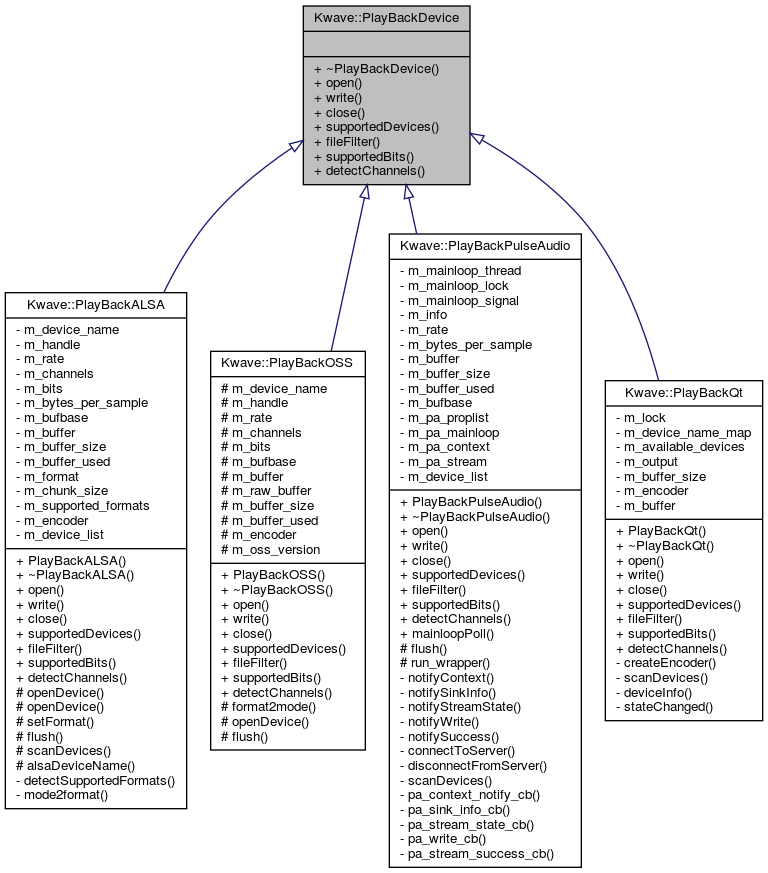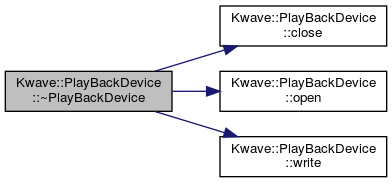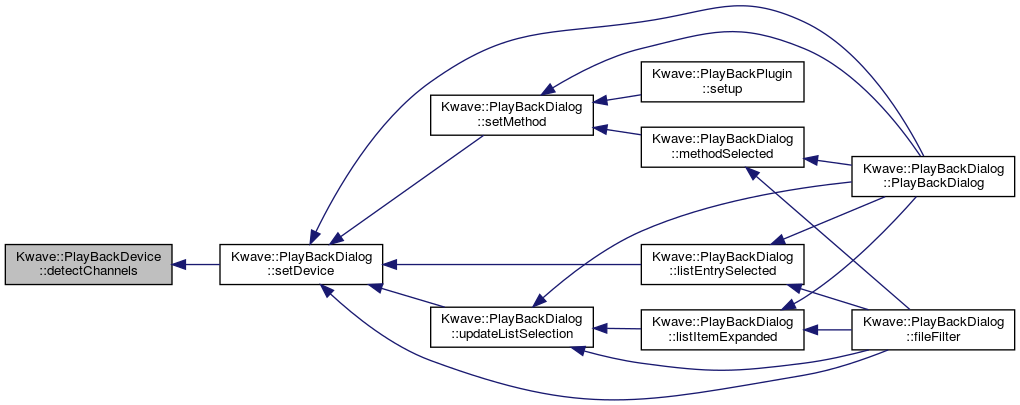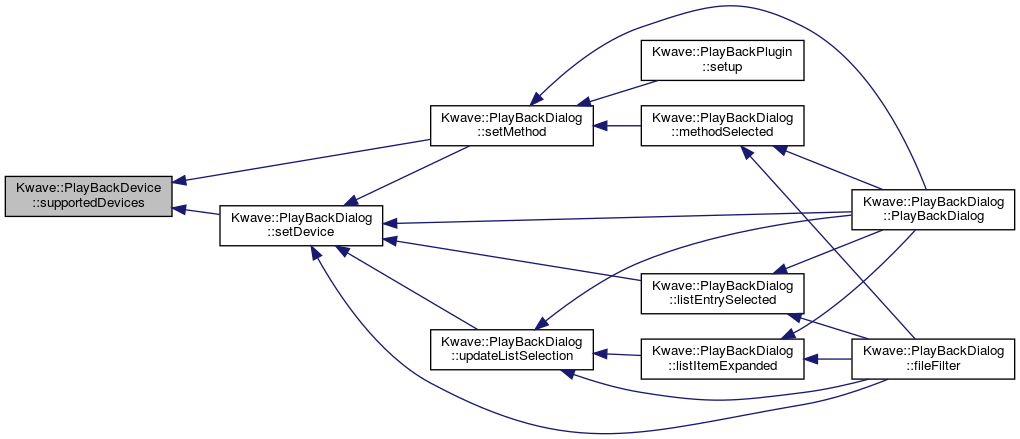#include <PlayBackDevice.h>


Public Member Functions | |
| virtual | ~PlayBackDevice () |
| virtual QString | open (const QString &device, double rate, unsigned int channels, unsigned int bits, unsigned int bufbase)=0 |
| virtual int | write (const Kwave::SampleArray &samples)=0 |
| virtual int | close ()=0 |
| virtual QStringList | supportedDevices () |
| virtual QString | fileFilter () |
| virtual QList< unsigned int > | supportedBits (const QString &device)=0 |
| virtual int | detectChannels (const QString &device, unsigned int &min, unsigned int &max) |
Detailed Description
Abstract base class for all kinds of playback devices. It provides only a minimum of necessary functions, like opening/closing and writing samples.
- Note
- this class is not threadsafe on its own, it relies on the threadsafe implementation of the PlayBack plugin.
- there aren no checks for avoiding close without open, opening twice or similar
- there are no precautions to prevent duplicate instances
Definition at line 46 of file PlayBackDevice.h.
Constructor & Destructor Documentation
◆ ~PlayBackDevice()
|
inlinevirtual |
Destructor
Definition at line 51 of file PlayBackDevice.h.
References close(), open(), and write().

Member Function Documentation
◆ close()
|
pure virtual |
Closes the output device.
Implemented in Kwave::PlayBackPulseAudio, Kwave::PlayBackQt, Kwave::PlayBackALSA, and Kwave::PlayBackOSS.
Referenced by Kwave::MultiPlaybackSink::~MultiPlaybackSink(), and ~PlayBackDevice().

◆ detectChannels()
|
inlinevirtual |
Detect the minimum and maximum number of channels. If the detection fails, minimum and maximum are set to zero.
- Parameters
-
device filename of the device min receives the lowest supported number of channels max receives the highest supported number of channels
- Returns
- zero or positive number if ok, negative error number if failed
Reimplemented in Kwave::PlayBackPulseAudio, Kwave::PlayBackQt, Kwave::PlayBackALSA, and Kwave::PlayBackOSS.
Definition at line 111 of file PlayBackDevice.h.
Referenced by Kwave::PlayBackDialog::setDevice().

◆ fileFilter()
|
inlinevirtual |
return a string suitable for a "File Open..." dialog
Reimplemented in Kwave::PlayBackPulseAudio, Kwave::PlayBackQt, Kwave::PlayBackALSA, and Kwave::PlayBackOSS.
Definition at line 90 of file PlayBackDevice.h.
References _, and supportedBits().
Referenced by Kwave::PlayBackDialog::setMethod().


◆ open()
|
pure virtual |
Opens the device for playback.
- Parameters
-
device name of the output device, this might be a file name of a device or any user-defined string that tells the playback device where to write data. rate playback rate [samples/second] channels number of playback channels [1=mono, 2=stereo,...] bits resolution for output [bits/sample] bufbase exponent of the buffer size. The real buffer size will be (2 ^ bufbase) bytes.
- Returns
- zero-length string if successful, or an error message if failed
Implemented in Kwave::PlayBackPulseAudio, Kwave::PlayBackQt, Kwave::PlayBackALSA, and Kwave::PlayBackOSS.
Referenced by Kwave::PlaybackController::openDevice(), and ~PlayBackDevice().

◆ supportedBits()
|
pure virtual |
returns a list of supported bits per sample resolutions of a given device.
- Parameters
-
device filename of the device
- Returns
- list of supported bits per sample, or empty on errors
Implemented in Kwave::PlayBackPulseAudio, Kwave::PlayBackQt, Kwave::PlayBackALSA, and Kwave::PlayBackOSS.
Referenced by fileFilter(), and Kwave::PlayBackDialog::setDevice().

◆ supportedDevices()
|
inlinevirtual |
return a string list with supported device names
Reimplemented in Kwave::PlayBackPulseAudio, Kwave::PlayBackQt, Kwave::PlayBackALSA, and Kwave::PlayBackOSS.
Definition at line 85 of file PlayBackDevice.h.
Referenced by Kwave::PlayBackDialog::setDevice(), and Kwave::PlayBackDialog::setMethod().

◆ write()
|
pure virtual |
Writes an array of samples to the output device. Each sample in the array is designated to one output channel.
- Parameters
-
samples array of samples for output
- Returns
- 0 if successful, or an error code if failed
Implemented in Kwave::PlayBackPulseAudio, Kwave::PlayBackQt, Kwave::PlayBackALSA, and Kwave::PlayBackOSS.
Referenced by Kwave::MultiPlaybackSink::input(), Kwave::PlaybackController::run_wrapper(), and ~PlayBackDevice().

The documentation for this class was generated from the following file:
- libkwave/PlayBackDevice.h
